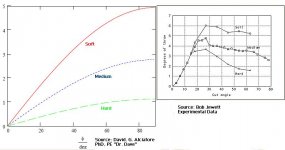enzo said:
... my point is, more surface area in contact should translate to increased friction, and thus increased throw. i wonder why that is not the case. i guess the effects of slow speed just overshadow and effects of increased contact area.
As Bob Jewett indicated, the amount of friction is for the most part independent of the size of the contact area. You can get a feeling for why this is true by considering that the compression force acting perpendicular to the surfaces functions as sort of pressure, even though we're dealing with solid objects. The force is distributed over the area of contact. For a given amount of force, a smaller area results in a greater pressure while a larger area results in a smaller pressure. The magnitude of the pressure is in fact the compression force divided by the area, so when you multiply the pressure by the area to get the magnitude of the compression force, not too surprisingly, the area cancels out.
Here is one way of seeing why the friction force diminishes with relative surface speed. It's a complicated subject so this is a blatently amatuerish explanation.
If you picture the surface on the microscopic scale, it consists of tiny mountains and valleys, even on a polished surface. As one surface is moved across the other, the peaks collide. Since the mountains are sloped, the collisions tend to push the surfaces apart as well as resisting the motion, the latter being the friction. The faster the surface motion, the more the surfaces are pushed apart. The mountains now collide at points closer to their summits. Since the mountains are generally more gradualy sloped as you approach their summits (less steep), the direction of the collision force becomes more perpendicular to the surfaces. Consequently, you get less force in the parallel direction. You also get fewer collisions per unit distance of travel because fewer of the mountains of one surface can reach those on the other surface. And, the smaller summit areas are easier to shear off.
All of this leads to less friction.
This may be way too simplistic, perhaps flat out wrong, but it works for me.
Jim

